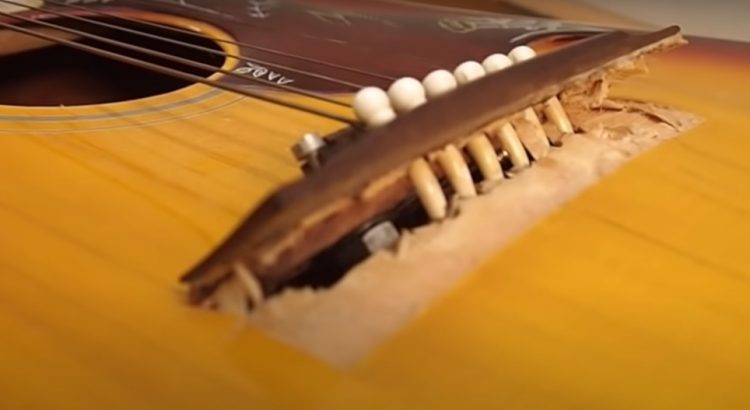Around the time when America was at the peak of The Great Depression (1929-39), Gibson, then a 30-something-year-old guitar manufacturer, incorporated a few design changes that stuck on for a few decades. One of these was the use of nuts and bolts as fastners in an acoustic guitar bridge.
How do you know if your bridge has nuts and bolts in it? Look for two white dots, one each on either side of the bridgepin holes (In the photo below, there are three).

When Gibson launched the concept, they covered up the bolt heads with a little, round piece of Mother of Pearl. The economics of it soon forced them to discard Mother of Pearl as an option, and later versions used celluloid instead.
Luthiers and the global guitar community is still debating whether the rationale was for the bolts to act as locators or fastners. Gibson itself says that the idea of the bolts was to locate the bridge exactly where it needed to go.

As fastners, the idea was that the hardware would help hold the bridge securely to the top, even if the glue dried up. How wrong that thinking was, we’ll soon see.
As locators, the idea seemed to be that the nuts and bolts would help keep the bridge in exactly the spot that it needed to be, disallowing the possibility of bridge creep under clamp pressure (If too much glue is used in bridge glue-up jobs, before it cures, the glue acts more like a lubricant, allowing the bridge to shift from its actual position).
That, according to me, is flawed reasoning. The same job could be done easier and almost as well with two bridgepins stuck in the 1st and 6th bridgepin hole. If there was a fear that the pins would get stuck in their holes, they could have been waxed.
Seen with the help of a mirror taken into the guitar body through the soundhole, the whole bridgeplate assembly would look something like this.

Those backing the use of nuts and bolts aver that it improves sound quality. I will not dare comment on that for I have never had the occasion to study differences in sound of a guitar with a bridge affixed with nuts and bolts, and one without.
What I will say with a certain degree of conviction is that the difference in sound – if any – would be so minuscule that the average player would never be able to make out the difference in sound of a guitar with the hardware and without it.
In fact, I will go out on a limb and say that if the hardware is removed from an instrument and it is given to the owner to play, not even he/she will be able to perceive the so-called change in sound!
Why nuts ‘n’ bolts are dangerous
In any acoustic steel string guitar, the force exerted by the strings is nearly 80 kg. Due to that constant 80-kg tension that the strings exert, it is a natural process that with the passage of time, the belly of the guitar (the area directly behind the bridge) starts lifting. Nothing very dramatic, but it is a very gradual but perceptible change. This happens when the bridge is stuck very well to the top.
In instruments that do not use nuts and bolts and the bridge is not stuck very well, the bridge just lifts and finally comes unstuck.
However, in case the bridge is not stuck very well and lifts, and it is being held down with nuts and bolts (yes, even with nuts and bolts, the string tension will lift the bridge), the hardware will rip through the bridgeplate (below the top) and the top. The owner, then, is left with two options: throw the guitar away, or, have it repaired at great expense. This is major surgery we are talking here!

So, why do manufacturers continue to hold down bridges with nuts and bolts? The world over, most manufacturers have given it up as a bad idea. Only in India, do we find manufacturers clinging on to it. Simply put, there are two reasons for them doing so. 1) It is easier to use nuts and bolts than to REALLY clean the two glueing surfaces of all paint and finish to get a good wood-to-wood joint, and 2) in the mistaken belief that they are lending solidity to the structure!
Here’s one from an Indian manufacturer that I had the misfortune of looking at. Not right away, but a couple of years or so down the line, I won’t be surprised if it comes to me with a ripped top. The lines on the paper strips represent the amount the strips slip under the bridge.




I won’t name the manufacturer here, but I am sure they will be able to recognise their product.
The famed Gibson company may have learned its lesson and discontinued the practice of fastening bridges with nuts and bolts. When will Indian guitar manufacturers learn?
